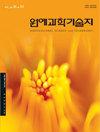Development of Antimicrobial Paper with Ag Nanoparticles Synthesized Using Rubus coreanus Leaf Extract to Extend the Storage Period for Strawberry
IF 0.8
4区 农林科学
Q3 HORTICULTURE
Korean Journal of Horticultural Science & Technology
Pub Date : 2021-08-01
DOI:10.7235/HORT.20210041
引用次数: 0
Abstract
This study developed an antimicrobial paper against major putrefactive pathogens in strawberry through integrating Rubus coreanus leaf extract and silver nitrate (AgNO3). The R. coreanus extract and silver nitrate were synthesized and then assayed by spectrophotometry. A peak was found around 400 nm, the wavelength of silver particle absorption. Synthesis of R. coreanus extract-silver nitrate was confirmed by transmission electron microscopy (TEM). It was found that R. coreanus extract was combined with round nanosilver particles 100 nm or smaller, along with some triangular, polygon, and stick forms. Nanosilver synthesis was developed using the R. coreanus extract as a reducing agent and then the developed antimicrobial paper was investigated by scanning electron microscope (SEM). Nanosilver particles of nanometer level were also found in the antimicrobial paper. Ag was found to be evenly distributed through energy dispersive x-ray spectroscopy (EDS) analysis, and R. coreanus extract was also contained in the antimicrobial paper. The developed antimicrobial paper showed antimicrobial effects against all three putrefactive pathogens: Botrytis cinerea, Alternaria tenuissima, and Rhizopus stolonifer. Compared with general paper, the antimicrobial paper also minimally changed postharvest strawberry weight and hardness, helping to maintain fruit quality and lengthen the storage period. Additional key words: fruit quality, natural extracts, postharvest, putrefactive microorganisms, silver nitrate用悬钩子叶提取物合成纳米银抗菌纸延长草莓贮藏期的研究
以草莓叶提取物和硝酸银(AgNO3)为原料,制备了一种抗草莓主要腐败病菌的抗菌纸。合成了小檗提取物和硝酸银,用分光光度法测定其含量。在400 nm波长附近发现了银粒子的吸收峰。通过透射电子显微镜(TEM)对其合成过程进行了验证。结果表明,小茴香提取物与100 nm以下的圆形纳米银颗粒结合,并伴有三角形、多边形和棒状结构。以小茴香提取物为还原剂制备了纳米银,并对制备的抗菌纸进行了扫描电镜观察。在抗菌纸中还发现了纳米级的纳米银颗粒。能谱分析发现银均匀分布,抗菌纸中也含有银提取物。所研制的抗菌纸对三种腐败病原菌:灰霉病菌、蛇纹病菌和匍匐茎霉均有抗菌作用。与普通纸相比,抗菌纸对草莓采后重量和硬度的影响最小,有利于保持果实品质,延长贮藏期。附加关键词:果实品质,天然提取物,采后,腐烂微生物,硝酸银
本文章由计算机程序翻译,如有差异,请以英文原文为准。
求助全文
约1分钟内获得全文
求助全文
来源期刊
CiteScore
2.00
自引率
0.00%
发文量
0
审稿时长
1 months
期刊介绍:
Horticultural Science and Technology (abbr. Hortic. Sci. Technol., herein ‘HST’; ISSN, 1226-8763), one of the two official journals of the Korean Society for Horticultural Science (KSHS), was launched in 1998 to provides scientific and professional publication on technology and sciences of horticultural area. As an international journal, HST is published in English and Korean, bimonthly on the last day of even number months, and indexed in ‘SCIE’, ‘SCOPUS’ and ‘CABI’. The HST is devoted for the publication of technical and academic papers and review articles on such arears as cultivation physiology, protected horticulture, postharvest technology, genetics and breeding, tissue culture and biotechnology, and other related to vegetables, fruit, ornamental, and herbal plants.

 求助内容:
求助内容: 应助结果提醒方式:
应助结果提醒方式:


